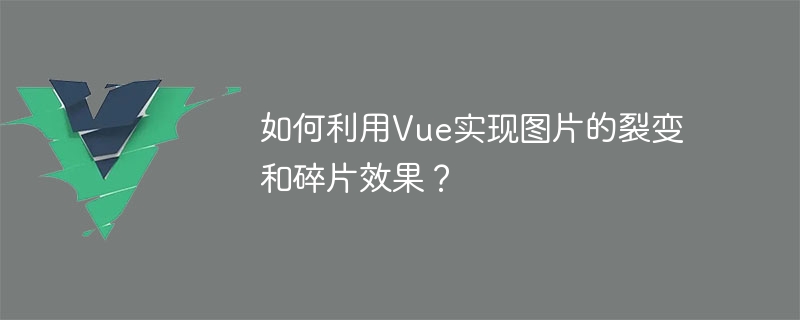如何利用Vue實現圖片的裂變和碎片效果?
- WBOYWBOYWBOYWBOYWBOYWBOYWBOYWBOYWBOYWBOYWBOYWBOYWB原創
- 2023-08-25 20:31:491056瀏覽

如何利用Vue實現圖片的裂變與碎片效果?
在前端開發中,常常需要為網頁增加一些特效來增強使用者體驗。其中,圖片的裂變和碎片效果是較常見的特效之一。本文將介紹如何利用Vue框架實現圖片的裂變和碎片效果,並附上相關的程式碼範例。
- 準備工作
首先,你需要準備一張圖片作為效果的展示對象。在Vue專案中,可以將圖片保存在assets資料夾中,並在元件中引用。 - 建立Vue元件
接下來,我們需要建立一個Vue元件來實現圖片的裂變和碎片效果。在元件的template中,可以使用<img alt="如何利用Vue實現圖片的裂變和碎片效果?" >標籤來展示圖片。同時,為了實現裂變和碎片效果,我們需要在data中定義一些狀態值來控制動畫效果的展示。
<template>
<div>
<img :src="imageUrl" : style="max-width:90%" alt="" />
<div class="particles" :style="particleStyle" v-if="showParticles"></div>
</div>
</template>
<script>
export default {
data() {
return {
imageUrl: require('@/assets/image.jpg'), // 替换成你的图片地址
imageStyle: {
width: '500px', // 根据图片大小设置宽度
height: 'auto', // 根据图片宽高比计算高度
position: 'relative',
},
particleStyle: {
position: 'absolute',
width: '10px',
height: '10px',
background: 'red', // 碎片的颜色
},
showParticles: false, // 是否展示碎片
}
},
mounted() {
// 设置一个定时器,在3秒后展示碎片效果
setTimeout(() => {
this.showParticles = true;
}, 3000);
},
}
</script>
<style scoped>
.particles {
width: 100%;
height: 100%;
overflow: hidden;
}
</style>- 實現裂變效果
要實現圖片的裂變效果,我們可以在mounted鉤子中使用canvas來處理圖片。具體步驟如下:
- 建立一個
canvas元素,並設定與圖片相同的寬高。 - 取得
canvas的上下文並使用drawImage方法將圖片繪製到canvas上。 - 使用
getImageData方法取得圖片的像素數據,然後對每個像素進行處理。 - 根據像素的位置和顏色,使用
fillRect方法在canvas上繪製一個個小的矩形,形成裂變效果。
以下是裂變效果的程式碼範例:
<template>
<div>
<canvas ref="canvas" :width="canvasWidth" :height="canvasHeight" />
<div class="particles" :style="particleStyle" v-if="showParticles"></div>
</div>
</template>
<script>
export default {
data() {
return {
imageUrl: require('@/assets/image.jpg'), // 替换成你的图片地址
imageStyle: {
width: '500px', // 根据图片大小设置宽度
height: 'auto', // 根据图片宽高比计算高度
position: 'relative',
},
particleStyle: {
position: 'absolute',
width: '10px',
height: '10px',
background: 'red', // 碎片的颜色
},
canvasWidth: 500,
canvasHeight: 0,
showParticles: false, // 是否展示碎片
}
},
mounted() {
const canvas = this.$refs.canvas;
const ctx = canvas.getContext('2d');
const img = new Image();
img.src = this.imageUrl;
img.onload = () => {
this.canvasHeight = (img.height * this.canvasWidth) / img.width;
canvas.width = this.canvasWidth;
canvas.height = this.canvasHeight;
ctx.drawImage(img, 0, 0, this.canvasWidth, this.canvasHeight);
const imageData = ctx.getImageData(0, 0, this.canvasWidth, this.canvasHeight);
const pixels = imageData.data;
// 对每个像素进行处理
for (let i = 0; i < pixels.length; i += 4) {
const r = pixels[i];
const g = pixels[i + 1];
const b = pixels[i + 2];
const a = pixels[i + 3];
const x = (i / 4) % this.canvasWidth;
const y = Math.floor(i / 4 / this.canvasWidth);
if (Math.random() < 0.5) {
ctx.fillStyle = `rgba(${r},${g},${b},${a / 255})`;
ctx.fillRect(x, y, 1, 1);
}
}
// 定时器,在3秒后展示碎片效果
setTimeout(() => {
this.showParticles = true;
}, 3000);
};
},
}
</script>- 實作碎片效果
要實現圖片的碎片效果,我們可以在data中定義一些變數來控制碎片的數量和位置。然後,在mounted鉤子中使用v-for循環產生碎片,並設定它們的位置和動畫效果。
以下是碎片效果的程式碼範例:
<template>
<div>
<canvas ref="canvas" :width="canvasWidth" :height="canvasHeight" />
<div class="particles" v-if="showParticles">
<div
class="particle"
:class="'particle-' + index"
v-for="(particle, index) in particles"
:key="index"
:style="{ left: particle.x + 'px', top: particle.y + 'px', animationDelay: particle.delay + 'ms' }"
></div>
</div>
</div>
</template>
<script>
export default {
data() {
return {
imageUrl: require('@/assets/image.jpg'), // 替换成你的图片地址
imageStyle: {
width: '500px', // 根据图片大小设置宽度
height: 'auto', // 根据图片宽高比计算高度
position: 'relative',
},
particleStyle: {
position: 'absolute',
width: '10px',
height: '10px',
background: 'red', // 碎片的颜色
},
canvasWidth: 500,
canvasHeight: 0,
showParticles: false, // 是否展示碎片
particles: [], // 碎片数组
}
},
mounted() {
const canvas = this.$refs.canvas;
const ctx = canvas.getContext('2d');
const img = new Image();
img.src = this.imageUrl;
img.onload = () => {
this.canvasHeight = (img.height * this.canvasWidth) / img.width;
canvas.width = this.canvasWidth;
canvas.height = this.canvasHeight;
ctx.drawImage(img, 0, 0, this.canvasWidth, this.canvasHeight);
const imageData = ctx.getImageData(0, 0, this.canvasWidth, this.canvasHeight);
const pixels = imageData.data;
// 对每个像素进行处理
for (let i = 0; i < pixels.length; i += 4) {
const r = pixels[i];
const g = pixels[i + 1];
const b = pixels[i + 2];
const a = pixels[i + 3];
const x = (i / 4) % this.canvasWidth;
const y = Math.floor(i / 4 / this.canvasWidth);
if (Math.random() < 0.5) {
ctx.fillStyle = `rgba(${r},${g},${b},${a / 255})`;
ctx.fillRect(x, y, 1, 1);
}
}
// 初始化碎片数组
for (let i = 0; i < 1000; i++) {
const x = Math.random() * this.canvasWidth;
const y = Math.random() * this.canvasHeight;
const delay = Math.random() * 2000;
this.particles.push({
x,
y,
delay,
});
}
// 定时器,在3秒后展示碎片效果
setTimeout(() => {
this.showParticles = true;
}, 3000);
};
},
}
</script>
<style scoped>
.particles {
width: 100%;
height: 100%;
overflow: hidden;
}
.particle {
position: absolute;
width: 10px;
height: 10px;
background: red; // 碎片的颜色
animation: particle-fade 2s ease-in-out infinite;
}
@keyframes particle-fade {
0% {
opacity: 1;
transform: translateY(0);
}
50% {
opacity: 0;
transform: translateY(20px);
}
100% {
opacity: 1;
transform: translateY(0);
}
}
.particle-0 {
animation-delay: 50ms;
}
.particle-1 {
animation-delay: 100ms;
}
.particle-2 {
animation-delay: 150ms;
}
/* ... */
</style>透過上述程式碼範例,我們可以在Vue中輕鬆實現圖片的裂變和碎片效果。當頁面載入後,圖片會先裂變成碎片,然後經過一段時間的動畫效果後,最終展示出完整的圖片。你可以根據實際需求調整程式碼中的參數,來達到你想要的效果。
希望這篇文章能對你理解Vue中圖片裂變和碎片效果的實作有所幫助!
以上是如何利用Vue實現圖片的裂變和碎片效果?的詳細內容。更多資訊請關注PHP中文網其他相關文章!
陳述:
本文內容由網友自願投稿,版權歸原作者所有。本站不承擔相應的法律責任。如發現涉嫌抄襲或侵權的內容,請聯絡admin@php.cn

